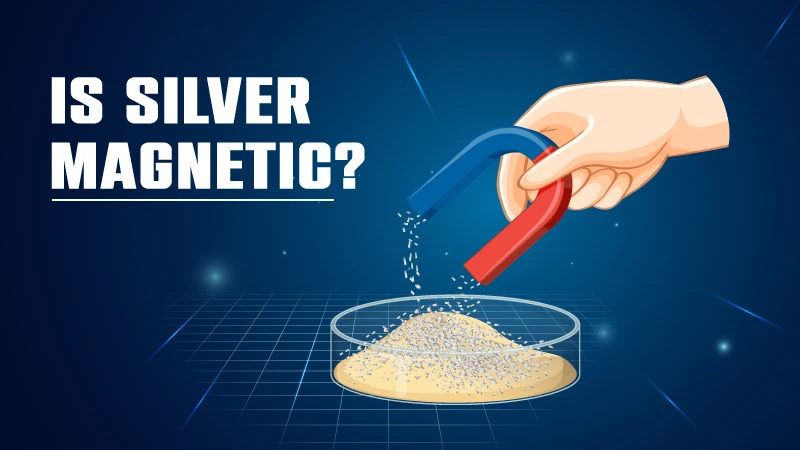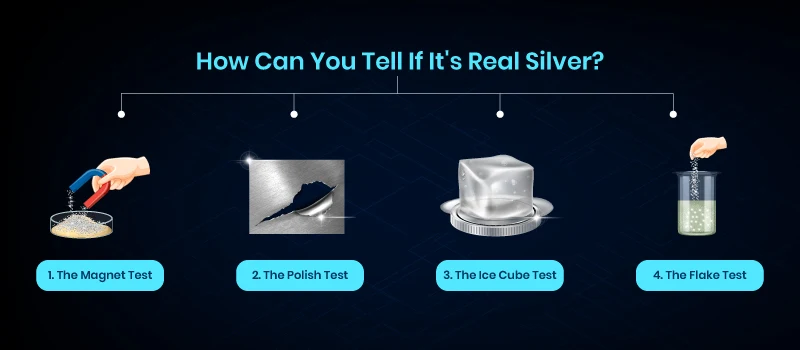Is Silver Magnetic Unraveling the Magnetic Mysteries of Silver Metal

By BullionMentor on February 4, 2024
Is silver magnetic? It is a question that many science buffs and enthusiasts of precious metals have probably wondered about. In short, the answer to this question is no, silver is not magnetic. Pure silver lacks intrinsic magnetic properties. Still, the chatter goes on. The number of counterfeit goods on the market has increased due to the growing demand for precious metals as investments. As a result, countless do-it-yourself (DIY) tests have been conducted on jewelry, cutlery, and bullion coins and bars to determine their purity.
The magnet test is one of the most popular methods for identifying phony silver bullion, raising the question: is silver magnetic?This article provides a comprehensive guide explaining how silver responds to a magnetic field and how to test silver bullion using that knowledge.Understanding Magnetism
Faraday's Law of 'Magnetic Induction’ states that the electrons of certain materials will change when exposed to magnetic fields.The atomic and molecular structure of the material under test and the item's total magnetic field affect the reaction. As a result, how an external magnetic field affects an element varies greatly.Materials can be classified as diamagnetic, paramagnetic, or ferromagnetic based on their reactions.How Does Magnetism Work?
Magnets produce a force that attracts or repels other objects, known as magnetism. Electromagnetism is one of the fundamental forces of nature that encompasses magnetism. All matter contains electrically charged particles that create a magnetic field as they move and produce electric currents. These particles act like small magnets, each having a north and south pole.Difference Between Ferromagnetic Paramagnetic and Diamagnetic Materials
| Properties | Ferromagnetic | Paramagnetic | Diamagnetic |
| Definition | The term ferromagnetism can be traced back to the word ferrous an abbreviation for iron. Iron was the first metal to display magnetic field-attractive characteristics, leading to this term's coinage. | The meaning of paramagnetic is related to the property of a material to be attracted towards a magnetic field. | The term diamagnetic refers to the repulsion of a material from an external magnetic field. |
| In Magnetic Force | Powerfully drawn to a magnet | Magnetized weakly | Weakly attracted to a magnet |
| Pairing | More than one unpaired electron | It has at least one unpaired electron | No unpaired electrons |
| Magnetic Susceptibility | High magnetic susceptibility | Positive and low | Small negative susceptibility |
| Relative Permeability | High | Greater than unity | Slightly less than unity |
| Example | Iron, nickel, and cobalt | Palladium, platinum, rhodium, rhenium, ruthenium, magnesium, molybdenum, lithium, and tantalum. | Most elements in the periodic table, including copper and pure gold (e.g., a .999 fine gold coin or gold bar), are classified as diamagnetic. |
Is Silver Magnetic?
There isn't much magnetism in silver. It's helpful to know that silver isn't magnetic since it makes counterfeit silver easier to identify. For instance, using a magnet to test someone trying to sell coins or silver jewelry is a good idea. They aren't pure silver if they are drawn to the magnet.How to Test Silver with a Magnet?

Silver, unlike copper and gold, is not magnetic. You can test this theory using magnets to see if they attract the object. According to Martin, silver exhibits only weak magnetic effects, unlike iron, nickel, cobalt, and similar metals. Martin states that if the magnet sticks firmly to the piece, it is not silver and has a ferromagnetic core. Most counterfeit silver or silver-plated items are made from other metals. This simple test can determine if your item is genuine silver.
Steps to Test Silver with Magnet
Assemble your materials on a plain work surface.
Put the magnet on top of the silver coin or bar first.
Pay attention to how the magnet behaves.
Do one more test with the magnet slide (for silver bars).
At a 45-degree angle, place the magnet on top of the silver bar.
Watch how the magnet descends the bar.
Is Sterling Silver Magnetic?
The Normans are credited with coining the term "sterling" because they adorned their silver pennies with stars. Over time, the original word "sterre" evolved into "starling", and eventually, "sterling" became the designation for British currency.Sterling silver isn't magnetic, just like pure silver. The alloy known as sterling silver comprises 92.5% silver by weight and 7.5% other metals, most often copper. Although copper doesn't make an alloy magnetic, it does increase its hardness and durability. As a result, sterling silver is also subject to the magnet test. It is most likely not real sterling silver if drawn to a magnet.How Can You Tell If It's Real Silver?
 You can perform a few tests to know the difference between real and fake silver.
You can perform a few tests to know the difference between real and fake silver.1
The easiest test you can do is the magnet test. As far as we know, gold and silver objects are not magnetic metals or meant to be drawn to one another. You should see your magnet fall due to the silver object repelling it. You can tell if the silver is fake if the magnet remains attached.The Magnet Test
2
A Polish test is a second easy exam. Silver tarnishes quickly and turns black. A white cloth and a small polish can be used to test your piece. Your piece is likely genuine silver if you see the black residue on the fabric after polishing it, and it regains its distinctive white luster.The Polish Test
3
The highest thermal conductivity is found in the element silver. Thus, an ice cube should melt more quickly on a silver object than an iron object.The Ice Cube Test
4
A layer of genuine silver may be applied to some objects to make them silver-plated. Does the object have flake material showing through to another metal underneath? When you scratch it with your fingernail, can you see another material underneath it? If so, the object is not sterling silver instead, it is plated with silver.Another option is to take some of the flakes and dissolve them in acid. If the silver is pure, its color should not change. You should only conduct this test on pieces you already own, as it is not something you can do at the store.